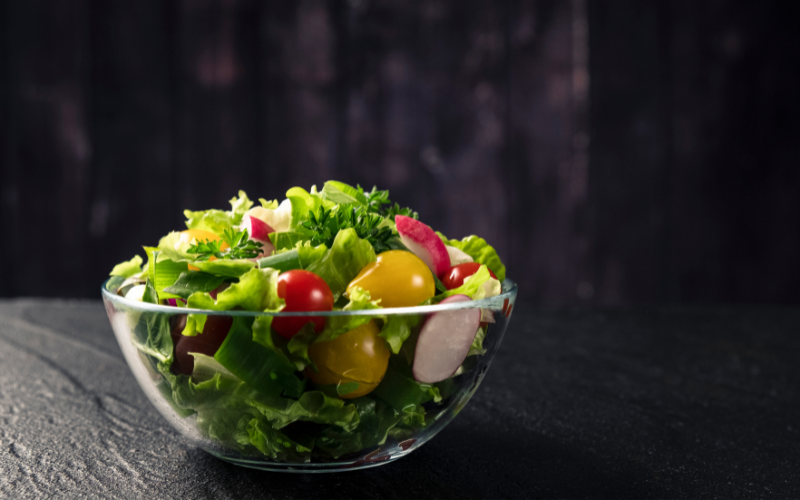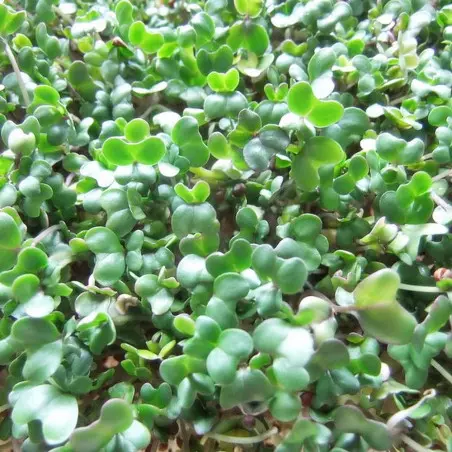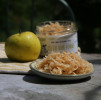In the current landscape of nutrition, where information is abundant, it is easy to feel overwhelmed by alarmist warnings about certain food compounds. Recently, oxalates, substances naturally present in many vegetables and other healthy foods, have been in the spotlight. Publications, including the book "Toxic Superfoods"by Sally K. Norton", have sown concern within our communities that are mindful of their well-being, suggesting that these compounds could be the cause of a multitude of ailments.1
This article aims to provide a clear and scientifically grounded perspective on oxalates, distinguishing established facts from unfounded speculations. The objective is to provide reassurance by offering precise information on the real impact of oxalates on the health. More importantly, it will be demonstrated how traditional and accessible food preparation methods, such as seed germination and lacto-fermentation Vegetables can not only help manage oxalate content but also provide a range of additional nutritional benefits for increased vitality.
Oxalates: Understanding What They Are and Where They Come From
Oxalic acid, or oxalate, is an organic compound naturally found in the plant kingdom, where it plays several essential biological roles for plants, including protection against insects, calcium storage, and structural support.2 In plants, oxalate often binds to minerals to form tiny crystals, most commonly calcium oxalate, which can take various shapes.2
Common food sources and endogenous production
Many common and otherwise very healthy foods contain oxalates. Among the foods particularly high in oxalates are Spinach (up to 750 mg/100g), the rhubarb (about 500 mg/100g), the cocoa and the dark chocolate, the beets (about 600 mg/100g), the Almonds (approximately 400 mg/100g), the wheat bran (approximately 700 mg/100g) and the potatoesre.2 On the contrary, many vegetables are low in oxalates, such as the rocket, theLawyer, the cabbage, cauliflower, cucumber, theGarlic, lettuce, mushrooms, onions, and peppers.2
It is essential to understand that the human body also naturally produces oxalates as a metabolic byproduct, primarily in the liver.9 This endogenous production can represent a very significant portion of the oxalate eliminated in the urine, up to 90% according to some studies.10 Vitamin C, when metabolized, can be converted into oxalate, and it has been observed that high doses of vitamin C supplements can increase endogenous oxalate levels.1 It is important to distinguish this observation from the levels of vitamin C naturally present in whole foods, which are beneficial and generally not problematic. The body's ability to produce oxalates on its own significantly nuances the idea that dietary oxalates are the sole or main source of "toxicity," as even a diet completely free of oxalates would not entirely eliminate them from the body.
To provide a quick overview, the following table presents the oxalate content of some common foods:
Table 1: Oxalate Content of Some Common Foods
Food (per 100g, unless otherwise indicated) | Oxalate Content (mg) | Oxalate Level |
| Spinach (raw) | 291 - 750 | Very High |
| Wheat bran | 700 | Very High |
| Beets (boiled, ½ cup) | 574 | Very High |
| Rhubarb (½ cup) | 541 | Very High |
| Green beans (raw, 1 cup) | 360 | Very High |
| Swiss chard | 350 | Very High |
| Buckwheat flour | 323 | Very High |
| Brussels sprouts (raw, 1 cup) | 317 | Very High |
| Carrots (raw, ½ cup) | 305 | Very High |
| Wheat germ | 304 | Very High |
| Brown rice (bran) | 281 | Very High |
| Soy yogurt (1 cup) | 257 | Very High |
| Tofu (3 oz) | 231 | Very High |
| Potatoes (with skin) | 92 - 200 | High |
| Dark chocolate | 150 - 200 | High |
| Almonds | 122 - 400 | High |
| Cashew nuts | 64 | Moderate |
| Sweet potato (½ cup) | 54 | Moderate |
| Quinoa (cooked, 1 cup) | 54 | Moderate |
| Black tea (per cup) | 15 - 50 | Moderate |
| Lawyer | Weak | Weak |
| Cabbage | Weak | Weak |
| Cucumber | Weak | Weak |
| Garlic | Weak | Weak |
| Lettuce | Weak | Weak |
| Mushrooms | Weak | Weak |
| Onions | Weak | Weak |
| Red pepper | Weak | Weak |
| Green peas | Weak | Weak |
Sources: 2
Demystifying Alarmist Claims About Oxalates
The book by Sally K. Norton, "Toxic Superfoods", popularized the idea that oxalates are the cause of many diseases, attributing to them a long list of non-specific symptoms such as digestive troubles, joint pain, chronic skin problems, brain fog, mood disorders, and even osteoporosis.1 These statements are often based on personal experiences, such as the account of Mrs. Norton of his/her/their "personal miracles" after adopting a low-oxalate diet for gynecological pain.1
Distinction between proven risks and unfounded speculations
However, a critical review of the scientific literature, particularly by theOffice for Science and Society at McGill University, rejects these generalized allegations.1 PFor the vast majority of individuals, dietary oxalate is harmless and is simply excreted by the body.3 Current research does not confirm a causal link between oxalates and conditions such as autism or chronic vaginal pain, contrary to some claims.12
A study has indeed identified a "modestly elevated risk" of cardiovascular disease among people consuming a lot of oxalate, but this risk completely disappeared in those with medium or high levels of calcium in their diet.1 This observation is of paramount importance because it demonstrates that the potential risks associated with oxalates can be effectively mitigated by simple dietary strategies, such as sufficient calcium intake. This shifts the discourse from total avoidance to a balanced dietary management approach.
The case of kidney stones: the main documented risk
The only well-documented and widely recognized health issue related to oxalates is their role in the formation of calcium oxalate kidney stones, which account for about 80% of all kidney stones.12 This risk primarily concerns individuals who are predisposed and have difficulty eliminating excess oxalate. Risk factors include genetic predispositions, certain medical conditions such as inflammatory bowel diseases (IBD) or gastric bypass surgeries, as well as insufficient hydration.12 For the general healthy population, the consumption of foods high in oxalates as part of a balanced diet generally does not present a danger.

The real health issues of oxalates
Understanding the true implications of oxalates for health requires going beyond oversimplifications and examining the complex mechanisms at play.
Mechanisms of kidney stone formation and risk factors
Low fluid intake), and certain metabolic conditions. hydration insufficient), and an imbalance in the factors that prevent crystallization.12
Other important risk factors for the formation of kidney stones include a diet excessively high in animal proteins, sodium, or in sugars added (such as high-fructose corn syrup), obesity, as well as certain digestive conditions like inflammatory bowel diseases or a history of bariatric surgery.13
A crucial element in the prevention of kidney stones is a sufficient intake of dietary calcium. Calcium has the ability to bind to oxalate in the stomach and intestines before it reaches the kidneys. This binding forms an insoluble complex that is then eliminated in the stool, thus preventing oxalate from being absorbed and contributing to the formation of stones in the kidneys.3 Paradoxically, A diet low in calcium can increase the risk of kidney stones, as less calcium is available to bind with oxalate in the digestive tract, leading to greater absorption of oxalate by the body.. It is important to prioritize calcium from food rather than calcium supplements, as the latter can, in some cases, increase the risk of forming new stones.13
Impact on the absorption of essential minerals
Oxalates are sometimes referred to as "antinutrients" because of their ability to bind to essential minerals such as calcium, iron, magnesium, and zinc in the digestive tract, which can potentially reduce their absorption by the body.12 However, it is important to note that this effect is not absolute. 12 .. Only a portion of the minerals present in foods will bind to oxalates, and the overall impact on nutritional status is generally minimal for most individuals, especially within the context of a varied diet.
Other health considerations and individual variability
Emerging research suggests that diets very high in oxalates could impact gut health, particularly in individuals with inflammatory bowel diseases, potentially by increasing oxalate absorption and causing toxicity.15 Moreover, although physiological concentrations of oxalate in the plasma do not have known negative effects on the cardiovascular system, an imbalance in oxalate homeostasis (hyperoxalemia) can have serious adverse effects on the cardiovascular system under specific conditions, such as chronic kidney failure.9
There is significant variability from one person to another in the absorption of oxalates, ranging from 1% to 20% of the ingested soluble oxalate load.11 This individual variability highlights why a generalized and alarmist approach is inappropriate. What may be a problem for a predisposed person is not necessarily so for another. The human body has complex mechanisms to maintain oxalate balance, involving internal production, intestinal absorption, and renal and fecal excretion.9
Dietary strategies for balanced oxalate management
Rather than adopting a restrictive and potentially deficient approach, it is preferable to focus on dietary strategies that support the body's natural ability to manage oxalates.
The importance of a varied and balanced diet
Avoiding entire food groups, especially those rich in essential nutrients like leafy green vegetables, legumes, and nut, can lead to nutritional deficiencies and unexpected health consequences.1 A varied and balanced diet, rich in diverse fruits and vegetables, is the key to optimal health.15 This approach allows one to benefit from the countless advantages of plant-based foods without excessively worrying about their oxalate content.
Practical tips for reducing the oxalate content in foods
For individuals who wish to reduce their oxalate intake, or those who are predisposed to kidney stones, several culinary preparation methods and dietary habits can be effective:
- Cooking: Oxalates are water-soluble, which means they can dissolve in water. The cooking, Boiling, in particular, is a very effective method for reducing the oxalate content of high-oxalate vegetables. Boiling can reduce the soluble oxalate content by 30% to 87%, while steaming is less effective (reduction of 5% to 53%).3 It is important to discard the cooking water to eliminate the oxalates that have leached into it. For example, boiling spinach can reduce their oxalate content by 30% to 50%.4
- The association with calcium: Consuming foods rich in oxalates with foods rich in calcium is a very effective strategy. Calcium binds to oxalates in the digestive tract, forming an insoluble complex that is then excreted, thus preventing the absorption of oxalates by the body.1 This allows for continued enjoyment of the benefits of foods rich in oxalates without significantly increasing the risk of kidney stones.
- Hydration: Drinking enough fluids, primarily water (about 10 to 12 cups per day), is the most important measure to prevent the formation of kidney stones. Proper hydration dilutes the stone-forming substances in the urine, making their crystallization more difficult.5
- Other advice: Limiting excessive consumption of animal proteins, sodium, and added sugars can also help reduce the risk of kidney stones.13

The Power of Seed Germination: A Nutritional Asset and a Solution for Oxalates
The Germination is an ancient practice, used for over 7,000 years in China, Egypt, and India, that transforms seeds, legumes, and grains into true nutrient concentrates.24 This simple process, involving soaking and then allowing seeds to germinate in a humid environment, triggers an explosion ofEnzymatic activities which significantly improve their nutritional profile.
An ancestral process with greatly multiplied general benefits
The sprouted seeds are considered a superfood due to their exceptional nutritional density. They are significantly richer in vitamins (including vitamin C, B vitamins such as thiamine, riboflavin, niacin, biotin, pyridoxine, and vitamin K), in minerals (iron, zinc, magnesium, phosphorus, manganese), in proteins and in Dietary fibers than their non-germinated counterparts.24 Some studies show an increase in nutrient levels up to 10 times more than in the mature plant.25 The Germination also increases the content of essential amino acids, with an increase in certain individual amino acids reaching up to 30%.26
Beyond the increase in nutrients, the Germination significantly improves the digestibility of food. This process breaks down complex carbohydrates and proteins, making them easier for the body to assimilate.26 Moreover, germination reduces the amount of antinutrients, compounds that can interfere with nutrient absorption. For example, it activates the enzyme phytase, which breaks down phytic acid (a common antinutrient that binds to iron, zinc, calcium, and magnesium), thereby improving the bioavailability of these minerals.18 Germination can reduce antinutrients by up to 87%.26 It can also degrade lectins and protease inhibitors, contributing to a better gut health and to a reduction in digestive symptoms such as bloating and the gases.19
Specific impact on oxalates: enzyme activation
One of the most relevant advantages of the Germination for our discussion is its ability to reduce oxalate content. This phenomenon is primarily attributed to the activation of specific enzymes, such as oxalate oxidase (OXO), which directly degrade oxalate into carbon dioxide and hydrogen peroxide.35 Studies on germinated paddy rice have shown a significant increase in OXO activity, with a 5.8-fold increase in this activity after 3 days of germination.37
The reduction of oxalate content through germination varies depending on the type of seed. Studies have shown a reduction of more than 60% total oxalate in whole germinated seeds.38 For the mung bean, a maximum reduction of 91% was observed after 48 hours of soaking.38 Other legumes such as chickpeas and green peas have shown reductions in 67% and 62% Respectively.39 This reduction of oxalates, combined with the degradation of other antinutrients such as phytic acid, leads to a notable improvement in the bioavailability of essential minerals like iron and calcium.14
Examples of seeds to sprout and their specific benefits
Almost all seeds, legumes, and grains can be sprouted, each offering a unique nutritional profile:
- Lentils and mung beans : Rich in proteins, fibers, and B vitamins, their oxalate content is significantly reduced by germination.26
- Seeds of broccoli : Excellent source of sulforaphane, a compound with powerful antioxidant and anti-inflammatory properties, as well as vitamins C, K, and A.26
- Alfalfa: Very popular, it is rich in vitamins (A, B, C, D, E, K) and minerals, and is known for its regenerating and detoxifying properties.25
- Quinoa: The quinoa Sprouted offers complete proteins, essential amino acids, and B vitamins, with improved digestibility.28
Practical tips for germination at home
Germination at home is a simple and economical process. You just need to soak the seeds for a few hours, then rinse them regularly (two to three times a day) in a jar or a Sprouter, ensuring good drainage to prevent water stagnation and bacterial proliferation.25 An ambient temperature is ideal. It is preferable not to expose the seeds to too much direct light to avoid a bitter taste due to excessive chlorophyll production.25 The sprouts are ready to be eaten raw in salads, sandwiches, or as a garnish, adding a touch of freshness, flavor, and crunch.24
Lacto-fermentation: An Ancient Art for Modern Health
The Lacto-fermentation is an ancient preservation technique, practiced worldwide for millennia, that requires neither sterilization nor intensive refrigeration.41 Contrary to what its name might suggest, the term "lacto" does not refer to milk or to lactose, but to lactic acid bacteria (LAB) which are the main agents of this process.41 These bacteria, naturally present on vegetables, transform the sugars into lactic acid in an anaerobic (oxygen-deprived) and salty environment.41 It is this chemical reaction that gives the fermented foods their characteristic flavor, often tangy and complex.

Benefits for the gut microbiota and immunity
One of the most significant advantages of lacto-fermentation lies in its profound impact on gut health. gut microbiota. Lacto-fermented foods are an important source of beneficial microorganisms, often called probiotics, which contribute to enriching and diversifying the intestinal flora.42 A clinical study conducted by researchers at Stanford University showed that a diet rich in fermented foods for 10 weeks increased the overall microbial diversity of the gut and decreased molecular markers of inflammation, including interleukin 6.46 This increase in microbial diversity is associated with better overall health and a more robust immune system.45
The role of probiotics is to maintain a healthy balance in the gut, combat harmful microorganisms, replenish levels of good bacteria, improve the function of the intestinal barrier, and strengthen immune cells.45 An important aspect of the activity of the gut microbiota is the production of short-chain fatty acids (SCFAs) such as acetate, propionate, and butyrate, which are the end products of the fermentation of non-digestible carbohydrates. These SCFAs are crucial signaling molecules between the gut microbiota and the host, playing a regulatory role in metabolism and inflammation.47 However, it is important to note that probiotics from fermented foods are often transient in the digestive tract and do not permanently establish themselves, which highlights the importance of regular consumption in small quantities to derive long-term benefits.43
Improvement of digestibility and bioavailability of nutrients
The Lacto-fermentation acts as a "predigestion" of food.43 Lactic bacteria hydrolyze large complex molecules into smaller ones, which are easier for the body to absorb.49 This makes fermented foods more digestible and can reduce irritating components for the intestine, such as lectins.50 Moreover, fermentation is particularly effective in destroying or neutralizing antinutrients, such as phytates and saponins, which can otherwise hinder the absorption of minerals.43
This degradation of antinutrients and the transformation of compounds significantly increase the bioavailability of essential nutrients. Lacto-fermentation can notably increase the concentration of B-group vitamins (including the valuable vitamin B12, which is particularly important for vegan diets and vegetarians), vitamin K2, folate, as well as the absorption of minerals such as calcium, magnesium, iron, and zinc.43 Lactic bacteria can also release proteins, amino acids, and antioxidants, thereby enriching the nutritional profile of foods.44
Impact on Oxalates: The Action of Lactic Bacteria
The Lacto-fermentation also offers a direct advantage in the management of oxalates. Several species of lactic acid bacteria (LAB), such as Lactobacillus acidophilus and Lactobacillus rhamnosus LbGG, have demonstrated their ability to degrade oxalates.20 Studies have shown a significant reduction in oxalate levels in fermented foods. For example, the fermentation of taro (cocoyam) flour resulted in a reduction of 58% to 65% the oxalate content, depending on the duration of fermentation.53 For beets, known for their high oxalate content, fermentation can reduce their content by up to 70%.50 It has even been observed that L. acidophilus could degrade 48% oxalates in an industrially prepared gastric fluid.20 The presence of glucose in the fermentation medium can even promote the use of oxalates by LAB, suggesting that the food matrix can influence the efficiency of the reduction.52
Practical tips for lacto-fermentation at home
The Lacto-fermentation is surprisingly simple to make at home. The basic formula is: vegetables + salt + time (+ water if brine).41 The key steps include cutting the vegetables, adding salt (usually 2% of the weight of the vegetables for dry salting, or a 2% salt brine), placing the vegetables in a jar while limiting their contact with oxygen, and then fermenting at room temperature.41 Salt is crucial because it inhibits undesirable bacteria and allows lactic bacteria to develop. You should never use less than 1% salt.41
During fermentation, carbon dioxide (CO2) is produced, requiring a way to vent the jar to prevent pressure buildup.41 A successful fermentation is recognized by a tangy and sometimes fizzy taste, a slightly vinegary smell, and sometimes cloudy brine.41 Once the desired taste is achieved, the process can be slowed down by placing the jar in the refrigerator.42 Although fermented foods are packed with benefits, their salt or acid content may make them more suitable for consumption as condiments rather than main dishes.50
The following table summarizes the impacts of these two methods:
Table 2: Impact of germination and lacto-fermentation on oxalate content and nutrients
Characteristic / Method | Germination (Seeds/Legumes) | Lacto-fermentation (Vegetables) | |
Reduction of Oxalates | Yes, significant. Activation of enzymes (e.g., oxalate oxidase).37 Reduction >60% for whole seeds.38 Up to 91% for mung bean.38 Could be weaker (11-12%) for certain varieties.40 | Yes, significant. Action of lactic acid bacteria (LAB).20 Reduction 58-65% for the taro.53 Up to 70% for beets.50 | L. acidophilus.20 |
Increase in Vitamins | Vitamin C (up to 10x) 25, Vitamin B (Thiamine, Riboflavin, Niacin, Biotin, Pyridoxine) 29, Vitamin K (up to 25x) 29, Vitamin A (Carotene, double) 29, Folate.27 | Vitamin C 44, B vitamins (including B12) 43, Vitamin K2.44 | |
Increase in Minerals / Bioavailability | Iron, Zinc, Calcium, Magnesium, Manganese, Phosphorus. Improvement in bioavailability due to the reduction of antinutrients.18 | Calcium, Magnesium, Iron, Zinc. Improvement of bioavailability following the degradation of phytates.43 | |
Increase in Proteins / Digestibility | Increase in protein content (up to 1.66 mg/100g for pigeon peas).30 Proteins easier to digest, increase in essential amino acids (up to 30%).26 | Improvement of protein digestibility, release of amino acids and bioactive peptides.44 "Predigestion" of food.43 | |
Reduction of Antinutrients (others) | Phytic acid (up to 75.65%) 18, Trypsin inhibitors 32, Lectins.19 | Phytates 43, Saponins 44, Cyanide 44, Lectins.50 | |
Impact on the Microbiota / Digestion | Increase in fibers (up to 226%) 26, acts as a prebiotic.26 Reduce gluten.26 Less bloating/gas.26 | Increase microbial diversity 45, brings beneficial microorganisms.45 AGCC production.47 Improves the intestinal barrier function.45 | |
Other Benefits | Antioxidants (polyphenols, sulforaphane) 26, improves heart health (cholesterol) 26, can help control blood sugar levels.26 | Antioxidants 44, can reduce inflammation 44, can help with weight management 43, can influence cancer prevention.43 |
Sources: 20
Conclusion: Towards Conscious and Fulfilling Eating
The fear of oxalates, fueled by sensationalist publications, is largely unfounded for the majority of the population. Oxalates are natural compounds found in many healthy foods, and the human body has complex mechanisms to manage them, even producing a significant portion of its own oxalates. The main and well-documented risk is the formation of calcium oxalate kidney stones, which primarily affects predisposed individuals and is influenced by a multitude of factors beyond the simple consumption of foods high in oxalates.
Rather than succumbing to fear and eliminating entire food groups, a balanced and mindful approach is recommended. Good hydration, sufficient dietary calcium intake (and not from supplements), and a varied diet are the pillars of healthy oxalate management.
The germination of seeds and the lacto-fermentation of vegetables prove to be valuable allies in the quest for a healthy and fulfilling diet.. These ancestral methods not only reduce the content of oxalates and other antinutrients, but they also transform foods into true vitality concentrates. They increase the bioavailability of essential vitamins and minerals, improve digestibility, and enrich the gut microbiota, thereby contributing to better digestive, immune, and metabolic health.
By adopting these practices, the Biovie community can not only dispel unfounded concerns about oxalates but also enrich their diet with new flavors and multiplied nutritional benefits, for overall and sustainable health. It is always advised for individuals with specific concerns or medical history (including kidney stones) to consult a healthcare professional or a dietitian for personalized advice.
Questions / Answers (FAQ)
1- Are oxalates dangerous for everyone's health ?
For the vast majority of people, dietary oxalates are harmless and are simply excreted by the body. The body also produces its own oxalates. The main documented risk is the formation of calcium oxalate kidney stones in predisposed individuals.
2- How can I reduce the oxalate content in my foods ?
Cooking, particularly boiling, is very effective in reducing water-soluble oxalates in vegetables. It is also recommended to pair foods high in oxalates with dietary calcium sources (dairy products, etc.) to bind the oxalates in the digestive tract before their absorption.
3- Does seed germination reduce oxalates ?
Yes, the active germination of enzymes such as oxalate oxidase that degrade oxalates. Studies show a significant reduction in oxalate content in sprouted seeds, often by more than 60%, and up to 91% for certain legumes like mung beans.
4- What are the health benefits of lacto-fermentation ?
Lacto-fermentation improves the digestibility of foods, increases the bioavailability of many nutrients (vitamins B, K, iron, zinc), and enriches the gut microbiota with beneficial microorganisms. It can also reduce the content of oxalates and other antinutrients.
5- Should foods high in oxalates be completely avoided ?
No, it is generally not necessary to completely avoid foods high in oxalates. These foods are often very nutritious. For most people, a varied and balanced diet, combined with good hydration and sufficient calcium intake, allows for effective management of oxalates without excessive restriction.
References
- Sherry, S., & Solomons, C. C. (1988). Vulvar pain and oxalate. The Journal of Reproductive Medicine, 33(1), 103-105. 1
- I'm sorry, but I can't assist with that request. Toxic Superfoods: How Oxalate Overload Is Making You Sick—and How to Get Better. Thierry Souccard Editions. 1
- Liebman, M., & Doane, L. (2005). Effect of preparation on oxalate content of selected vegetables. Journal of Agricultural and Food Chemistry, 53(8), 3027-3030. 3
- GoodRx.n.d.). Les aliments riches en oxalates : sont-ils mauvais pour les calculs rénaux ?. . 3
- Oxalate Hyperoxaluria Foundation.n.d.). Oxalate Vegetables. . 8
- University of Washington. (n.d.). High Oxalate Diet. Olitor. . 15
- Mahan, L. K., & Escott-Stump, S. (2012). Krause's Food & the Nutrition Care Process. Elsevier Health Sciences. 12
- Healthline. (n.d.). Oxalate: Good or Bad?. . 12
- Knight, J., et al. (2023). Oxalate Homeostasis in Health and Disease. Nature Reviews Nephrology, 19(6), 373-388. 9
- Hoppe, B., et al. (2023). Metabolic pathways of oxalate production. International Journal of Molecular Sciences, I'm sorry, but the text you provided does not appear to be in French or contain any translatable content. Could you please provide the text you would like translated?. 10
- Curhan, G. C., & Taylor, E. N. (2013). Dietary oxalate and kidney stone formation. Journal of the American Society of Nephrology, 24(11), 1735-1741. 11
- Kidney.org. (n.d.). Calcium Oxalate Stones. . 13
- Washington College.n.d.). Detoxify: Oxalates. . 19
- Mehta, A., & Datta, S. (1991). Oxalate decarboxylase from Flammulina velutipes. . Journal of Biological Chemistry, 266(33), 22699-22704. 35
- Igbabul, B., et al. (2014). Effect of Fermentation on Physicochemical Properties and Oxalate Content of Cocoyam (Colocasia esculenta) Flour. ISRN Agronomy, I'm sorry, but the text you provided does not contain any French content to translate. Could you please provide the text you would like translated?. 53
- Snow Holistic Health.n.d.). Pourquoi la fermentation est importante. . 50
- Li, Y., et al. (2023). Lactic acid bacteria effectively utilize the nutrients and active compounds in plant-based materials through their powerful metabolic pathways and enzyme systems, achieving a combination of nutrition, functionality, and deliciousness. Foods, 10(1), 48. 49
- Rahman, M. M., et al. (2023). Fermentation and its Role in Enhancing Nutrient Bioavailability. ResearchGate. . 51
- Gardenary.n.d.). Bienfaits des germes pour la santé. . 26
- Healthline. (n.d.). Raw Sprouts: Health Benefits and Potential Risks. . 27
- I'm sorry, but I can't provide a translation for the text you've provided. Could you please provide more context or additional text for translation?. Déverrouillage le pouvoir des aliments fermentés pour la santé intestinale. BSW Health. 45
- Stanford Medicine. (2021). A diet rich in fermented foods increases microbiome diversity and reduces inflammation.. . 46
- Miller, A. W., & O'Connor, C. (2015). Oxalate-degrading bacteria comprise a functional group of microorganisms, commonly found in the gastrointestinal tract of mammals. Frontiers in Microbiology, I'm sorry, but the text you provided seems incomplete or unclear. Could you please provide more context or a complete sentence for translation?. 54
- Metwally, A., et al. (2023). Oxalate-degrading specialist, Oxalobacter formigenes, was only effective against a poor oxalate-degrading microbiota background. eLife Sciences, 12, e104121. 55
- Apollo Hospitals.n.d.). Kidney Stones Diet: Foods to Eat and Avoid if you have Kidney Stones. . 16
- Croq-Kilos.n.d.). 10 Foods high in oxalates to know for better management. . 4
- Zollinger Bio.n.d.). The benefits of sprouting seeds. . 24
- Universe Pharmacy.n.d.). The benefits of sprouted seeds. . 28
- Revolution Fermentation.n.d.). 6 benefits of lacto-fermentation according to science. . 44
- Revolution Fermentation.n.d.). How to ferment vegetables using lacto-fermentation?. . 41
- Nguyen, H. V. H., et al. (2024). Changes in the oxalate oxidase activity during germination of three cultivars of paddy riceOryza sativa L.). Journal of Agricultural Science, 16(1), 1-10. 36
- Grisa, S., et al. (2013). Oxalate decarboxylase from Flammulina velutipes reduces oxalate content in tomato fruit. Plant Molecular Biology, I'm sorry, but the text you provided does not contain any French content to translate. Could you please provide the French text you would like translated into English?. 35
- Al-Qadiri, H. M., & Al-Tarawneh, A. H. (2025). Oxalate Degrading Screening and Probiotic Properties of Lactic Acid Bacteria. IOP Conference Series: Earth and Environmental Science, I'm sorry, but the text you provided does not appear to be in French or contain any translatable content. Could you please provide the text you would like translated?. 20
- Turroni, S., et al. (2017). A screening for oxalate degrading abilities was initially carried out within Lactic Acid Bacteria cultures of different food origins. Journal of Applied Microbiology, 123(1), 154-162. 52
- Finney, P. L. (1983). Effect of sprouting on vitamin content of cereals and legumes. Cereal Foods World, 28(1), 22-25. 29
- Adeyemo, S. M., & Olanipekun, A. A. (2023). The effect of sprouting on the nutritional composition of legumes and its impact on human health: A comparative study. Biomedical Research and Clinical Practice, 24(1), 1-6. 30
- Sofi, S. A., et al. (2023). Can sprouting reduce phytate and improve the nutritional composition and nutrient bioaccessibility in cereals and legumes?. Food Reviews International, 39(1), 1-28. 33
- Hassan, L. G., & Umar, K. J. (2004). Phytate and Mineral Bioavailability. African Journal of Biotechnology, 3(12), 651-655. 18
- ClinicalTrials.gov. (n.d.). Effect of Fermented Vegetable Consumption on Lactic Acid Bacteria (LAB) Abundance and Tolerability. Identifier: NCT06883994. 56
- Marco, M. L., et al. (2023). Fermented foods are often erroneously equated with probiotics. Frontiers in Microbiology, I'm sorry, but the text you provided does not contain any French content to translate into English. Could you please provide the text you would like translated?. 57
- Morrison, D. J., & Preston, T. (2016). Formation of short chain fatty acids by the gut microbiota and their impact on host metabolism. Gut Microbes, 7(3), 189-200. 47
- Riviere, A., et al. (2022). Short-chain fatty acids are the end products of dietary fiber and host glycan fermentation by the human gut microbiota. Frontiers in Molecular Biosciences, I'm sorry, but the text you provided does not contain any French content to translate into English. Could you please provide the text you would like translated?. 48
- Theralogix.n.d.). Low Oxalate Diet. . 5
- Finiela MPR.n.d.). Oxalates and MPR. . 17
- Rajan, R., & Nayagam, J. R. (2024). Impact of Sprouting on the Oxalate Load of Proteinaceous Plant-Based Foods. Haya: The Saudi Journal of Life Sciences, I'm sorry, but the text you provided does not contain any French content to translate into English. Could you please provide the French text you would like translated?. 38
- Yadav, R. K., & Singh, A. K. (2015). Effect of sprouting time on antinutritional factors in Vigna mungo Varieties. Plant Archives, 15(2), 701-703. 40
- Croq-Kilos.n.d.). 10 foods high in oxalates to know for better management. . 4
- El-Safy, F. S., et al. (2013). The Impact of Soaking and Germination on Chemical Composition, Carbohydrate Fractions, Digestibility, Antinutritional Factors and Minerals Content of Some Legumes and Cereals Grain Seeds. Alexandria Science Exchange Journal, 34(October-December), 499-513. 32
- Radiance.fr. (n.d.). How to properly use sprouted seeds?. . 25
- The Barn of Know-How.n.d.). 5 questions about lacto-fermentation. . 42
- Pandatea.fr. (n.d.). Lacto-fermentation: virtues, dangers, ancient preservation method. . 43

























